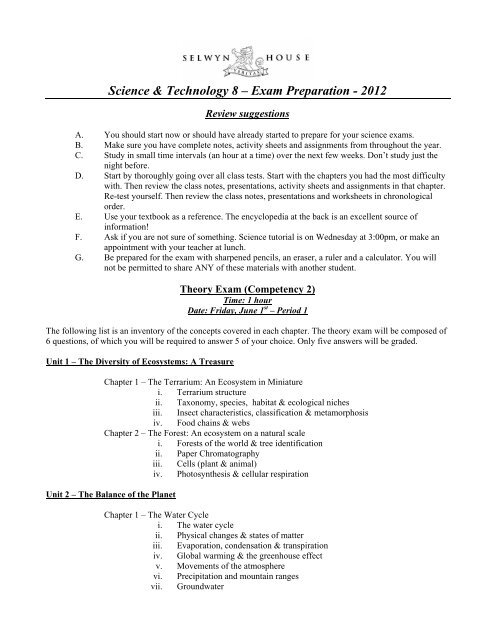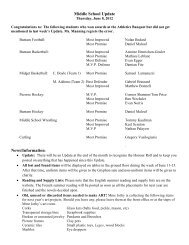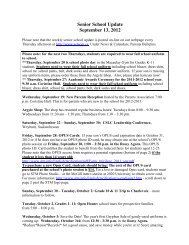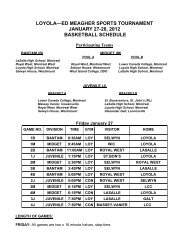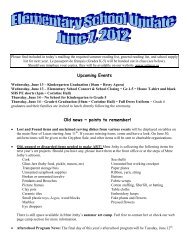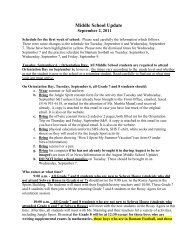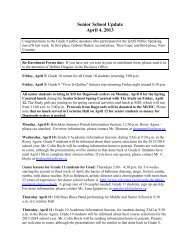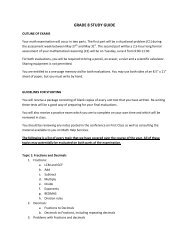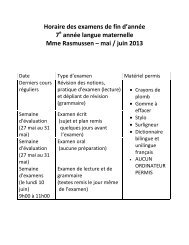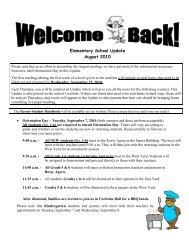Science & Technology 8 – Exam Preparation - 2012
Science & Technology 8 – Exam Preparation - 2012
Science & Technology 8 – Exam Preparation - 2012
Create successful ePaper yourself
Turn your PDF publications into a flip-book with our unique Google optimized e-Paper software.
<strong>Science</strong> & <strong>Technology</strong> 8 <strong>–</strong> <strong>Exam</strong> <strong>Preparation</strong> - <strong>2012</strong>Review suggestionsA. You should start now or should have already started to prepare for your science exams.B. Make sure you have complete notes, activity sheets and assignments from throughout the year.C. Study in small time intervals (an hour at a time) over the next few weeks. Don’t study just thenight before.D. Start by thoroughly going over all class tests. Start with the chapters you had the most difficultywith. Then review the class notes, presentations, activity sheets and assignments in that chapter.Re-test yourself. Then review the class notes, presentations and worksheets in chronologicalorder.E. Use your textbook as a reference. The encyclopedia at the back is an excellent source ofinformation!F. Ask if you are not sure of something. <strong>Science</strong> tutorial is on Wednesday at 3:00pm, or make anappointment with your teacher at lunch.G. Be prepared for the exam with sharpened pencils, an eraser, a ruler and a calculator. You willnot be permitted to share ANY of these materials with another student.Theory <strong>Exam</strong> (Competency 2)Time: 1 hourDate: Friday, June 1 st <strong>–</strong> Period 1The following list is an inventory of the concepts covered in each chapter. The theory exam will be composed of6 questions, of which you will be required to answer 5 of your choice. Only five answers will be graded.Unit 1 <strong>–</strong> The Diversity of Ecosystems: A TreasureChapter 1 <strong>–</strong> The Terrarium: An Ecosystem in Miniaturei. Terrarium structureii. Taxonomy, species, habitat & ecological nichesiii. Insect characteristics, classification & metamorphosisiv. Food chains & websChapter 2 <strong>–</strong> The Forest: An ecosystem on a natural scalei. Forests of the world & tree identificationii. Paper Chromatographyiii. Cells (plant & animal)iv. Photosynthesis & cellular respirationUnit 2 <strong>–</strong> The Balance of the PlanetChapter 1 <strong>–</strong> The Water Cyclei. The water cycleii. Physical changes & states of matteriii. Evaporation, condensation & transpirationiv. Global warming & the greenhouse effectv. Movements of the atmospherevi. Precipitation and mountain rangesvii. Groundwater
Chapter 2 <strong>–</strong> Biking for a Greener Planeti. Levers, pulleys & gearsii. Mechanical advantageiii. The bicycle (anatomy, function and development)iv. Heart rate & cadenceChapter 3 <strong>–</strong> Inventing Solutionsi. Archimedes’ Principle (density, buoyancy)Unit 3 <strong>–</strong> The Adventure of Living OrganismsChapter 1 <strong>–</strong> A Fascinating Developmenti. Evolution & Natural Selectionii. DNA, Chromosomes & Inheritanceiii. Sexual and Asexual Reproduction in Animalsiv. Sex Cells & Fertilizationv. The Reproductive Systemvi. Human Life Cycle (Pregnancy & Birth)vii. Puberty & Hormonesviii. The Menstrual Cycle, Pregnancy, & ChildbirthChapter 3 <strong>–</strong> Do Not Enteri. STBBIs & ContraceptionLab <strong>Exam</strong> (Competency 1)Time: 90 minutesDate: Thursday, June 7 thUsing the scientific method, you will be required to perform a task, analyze your results and draw conclusions.Theoretical knowledge of the course is required to be successful on this exam.Scientific / Experimental Methoda) Understand the components of conducting an experiment and their requirements:i. Purposeii. Hypothesis & Variables (Independent, Dependent and Control)iii. Materials & Procedureiv. Data & Observationsv. Results & Analysis (proper presentation and analysis of results)vi. Conclusionb) Lab skills & techniquesi. Proper use of lab equipment (electronic balance, graduated cylinder,overflow cup, dynamometer)ii. Laboratory safety rulesiii. Graphing of data using Microsoft Excel and by handiv. Leaf Identificationv. Insect Identificationvi. Chromatographyvii. Determination of density, pH, buoyancy & mechanical advantageviii. Microscope (plant / animal cell identification)Good luck!


